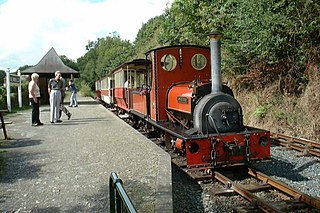
The Ravenglass and Eskdale Railway is a 15 in minimum gauge heritage railway in Cumbria, England. The 7-mile (11.3 km) line runs from Ravenglass to Dalegarth Station near Boot in the valley of Eskdale, in the Lake District. At Ravenglass the line ends at Ravenglass railway station on the Cumbrian Coast Line.
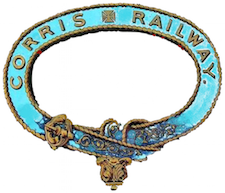
The Corris Railway is a narrow gauge preserved railway based in Corris on the border between Merionethshire and Montgomeryshire in Mid-Wales.
Bassett-Lowke was an English toy manufacturing company based in Northampton. Founded by Wenman Joseph Bassett-Lowke in 1898 or 1899, the company specialized in model railways, boats and ships, and construction sets. Bassett-Lowke started as a mail-order business, although it designed and manufactured some items.

The Lappa Valley Railway is a 15 in minimum gauge railway located near Newquay in Cornwall. The railway functions as a tourist attraction, running from Benny Halt to East Wheal Rose, where there is a leisure area with two miniature railways.
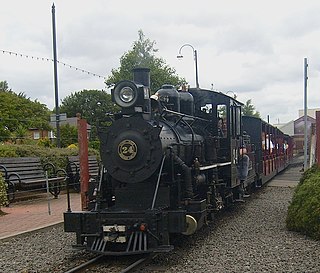
The Cleethorpes Coast Light Railway is a 15 in minimum-gauge railway that primarily serves holidaymakers in Cleethorpes, North East Lincolnshire, England. It operates from near the Cleethorpes Leisure Centre, running to the mouth of the Buck Beck.

The Midland Railway – Butterley is a heritage railway and museum complex at Butterley, near Ripley in Derbyshire.
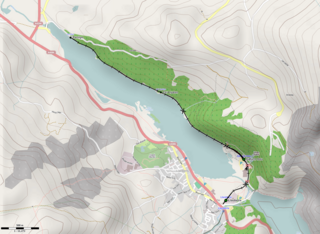
The Llanberis Lake Railway is a 1 ft 11+1⁄2 in narrow gauge heritage railway that runs for 2.5 miles (4 km) along the northern shore of Llyn Padarn in north Wales in the Snowdonia National Park. The starting point is the village of Llanberis at the eastern end of the lake, with the western terminus at Pen Llyn in the Padarn Country Park. The return journey takes around 60 minutes.

The Brecon Mountain Railway is a 1 ft 11+3⁄4 in narrow gauge tourist railway on the south side of the Brecon Beacons. It climbs northwards from Pant along the full length of the Pontsticill Reservoir and continues past the adjoining Pentwyn Reservoir to Torpantau railway station. The railway's starting point at Pant is located two miles (3 km) north of the town centre of Merthyr Tydfil, Merthyr Tydfil County Borough, South-East Wales.

The Sand Hutton Light Railway was a minimum gauge estate railway serving the estate of Sir Robert Walker, the Fourth Baronet of Sand Hutton, Yorkshire. It connected the main house with the LNER Warthill Station and the village of Bossall. It replaced the earlier, shorter, 15 in gauge Sand Hutton Miniature Railway that was built in 1914.

The Lincolnshire Coast Light Railway is a 2 ft narrow gauge heritage railway built in 1960 using equipment from the Nocton Potato Estate railway. It was originally located at Humberston, near Cleethorpes, and operated until 1985. The equipment was removed from storage and used to create a new railway at Skegness which opened on 3 May 2009.

The former Victorian Railways, the state railway authority in Victoria, Australia, built a number of experimental 2 ft 6 in narrow-gauge lines around the beginning of the 20th century. Although all were closed by the early 1960s, parts of two have been reopened as heritage railways.

Réseau Guerlédan was a short-lived railway in Côtes-du-Nord which operated from 1978 to 1979.
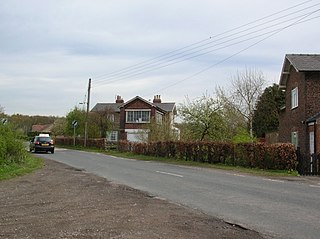
Warthill railway station was a station on the York to Beverley Line. It opened as Stockton station in 1847–8, was renamed to Stockton Forest in 1867; in 1872 it became Warthill station. The station closed in 1959.
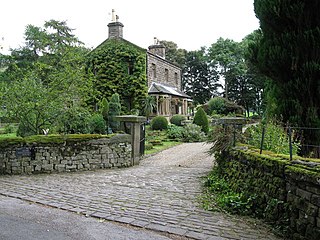
Nidd Valley Light Railway was a light railway in upper Nidderdale in the West Riding of Yorkshire, England. It was owned by Bradford Corporation Waterworks Department and the corporation also operated its public passenger services. Power & Traction Ltd of London obtained a Light Railway Order for the 6.5-mile (10.5 km) railway from Pateley Bridge to Lofthouse in 1900, but these powers were taken over by Bradford Corporation. A contract to build Angram Reservoir was awarded to John Best & Son in 1903, and he also won the contract to build the public railway and a 6.5-mile (10.5 km) private extension to the reservoir site. This was initially built to 3 ft gauge but was converted to standard gauge by 1907, when the public railway opened. Best had his own locomotives, and Bradford Corporation equipped the public railway with second hand locomotives and carriages from the Metropolitan Railway.

Whistlestop Valley, formerly the Kirklees Light Railway, is a visitor attraction featuring a 3+1⁄2-mile (5.6 km) long 15 in gauge minimum gauge railway. The attraction's main site is in the village of Clayton West in Kirklees, West Yorkshire, England which was first opened to the public on 19 October 1991, with a second, smaller site in a rural area near the village of Shelley.

Rudyard railway station served Rudyard, Staffordshire and was opened by the North Staffordshire Railway (NSR) in 1850 on the Churnet Valley line. In the village the NSR also owned the Rudyard Hotel as part of the company's efforts to develop Rudyard Lake and its environs as a tourist destination.
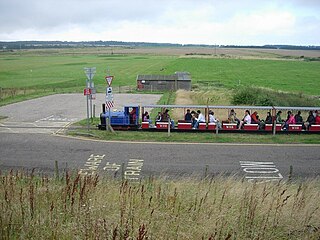
The Wells Harbour Railway was a 10+1⁄4 in gauge railway that ran at Wells-next-the-Sea, Norfolk, England. It was 1,200 yards (1,100 m) long, running between Wells Harbour and Pinewoods. The line operated for 45 years, from 1976 to 2021, when it was closed and replaced with a bus service.




